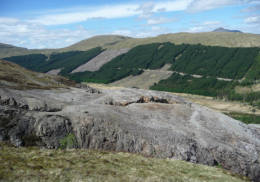
by Catherine Mills, University of Stirling
Date: February 21st 2018 4 p.m
Place: Palacio Cerveró. Main Conference Room.
Instituto de Historia de la Medicina y la Ciencia "López Piñero"
‘Occupational Exposure to Heavy Metals Poisoning: Scottish Lead Mining in the Eighteenth and Nineteenth Century’
The aim of this study is to increase the knowledge and understanding of the historic risk of both occupational exposure to lead and incidence of poisoning amongst mining labour. The research was prompted by a recent examination of the relationship between historic mining and pollution at an abandoned lead mine site at Tyndrum, Stirlingshire in the southern Scottish highlands (Mills, Simpson & Adderley). This revealed a clear association between environmental lead values and the quantity of ore extracted at the mine rather than with a particular period or technological innovation in the history of production at the site. It also indicated that of the three processes carried out at the mine, extraction, ore-dressing and smelting, it was the dressing processes that consistently generated the highest lead concentrations within the working environment. Current values were in some instances 200 times greater than background concentrations.
This raised key questions which this paper will address. To what extent were the workforce at risk of exposure; did the pollution production correlation follow through into the health of the workforce, was exposure moderated in some way by the factors that mediate absorption such as dose, bioavailability and duration of exposure and can the current lead legacy help in the understanding of the problems of the past?
To allow linkage between the current environmental record at the site and historic health events, this study returns to the Tyndrum site and its workforce, set against a wider national back drop, in the eighteenth and nineteenth centuries. Traditional archival research is combined with environmental science approaches and emphasis is placed upon employment practices, technology and wider social conditions such diet and alcohol and the toxicity of the different compounds of lead (mineralogy) that the workers were exposed too.
In conclusion it is suggested that an integrated approach helped to complete a narrative in the absence of mortality and morbidity data. Incidence of occupational poisoning occurred across all types of mining labour; miners, ore-dressers and smelters. Incidence was scattered and at fairly low level. The production and pollution correlation did not follow strongly through into health and poisoning correlates more persuasively with the duration of exposure to the contaminated environment. This was primarily moderated by the seasonal nature of mining in the pre-industrial phase and the adoption of a duel occupation which minimised contact with the metallic ore, and allowed the body periods of recuperation.
The paper is based on two published articles:
Catherine Mills; W. Paul Adderley ‘Occupational Exposure to Heavy Metals Poisoning: Scottish Lead Mining’, Social History of Medicine, 2016 doi: 10.1093/shm/hkw084
C. Mills, P. Adderley and I Simpson, ‘The Lead Legacy: The relationship between historical mining, metallurgical practices and heavy metals contamination’ Landscape History, 35, 1, (2014), 47-72
Retransmision online: http://reunion.uv.es/hcc2









